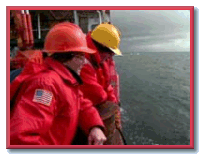
LTER PI Robin Ross monitors operations on board Polar Duke.
Robin Ross - February, 1997

LTER PI Robin Ross monitors operations on board Polar Duke. |
Robin Ross - February, 1997 |
|
From: Robin Ross, Aboard the Polar Duke (UCSB researcher Robin Ross is a member of the LTER team we encountered throughout the live programs. She helped create and review the "Phytoplankton See the Light" and other Activities in the Teacher's Guide, and LFA 2 thanks her, as well as her husband and co-worker Langdon Quetin, very sincerely.) Greetings from south of the Antarctic Circle!We on the RV Polar Duke are nearing the end of the Palmer LTER's annual cruise for the summer of 1997, with over 60 stations completed. Of the thousands of samples taken, many await analysis, either back at our home institutions or in the days ahead. These data will provide additional pieces in the large puzzle that the Palmer LTER team is putting together. We can think of each year as an experiment, where nature varies the timing and extent of sea ice, and the research team observes what happens to the microscopic microbes and plants, and the krill and penguins under those experimental conditions. The Palmer LTER shows a pattern of a few years of low ice extent, with a complete cycle every 6-8 years. Each cruise gives us a snapshot view of one mid-summer, but results from this year and other years need to be put in the context of the long-term variability before we can really understand how the ecosystem functions. It will take us quite a few years to find all the pieces to our puzzle!
From what has been analyzed, the Palmer LTER team is getting an idea of
how this sixth year of sampling stands in relation to other years. The
satellite ice images for this past austral winter and spring show that
sea ice advanced to above King George Island (over 600 kilometers north
of where we are now!) by August, and retreated to about 100 kilometers
south of Marguerite Bay (where we are now) by January. Parts of our
study region that have been packed with ice and unreachable by ship for
three years are free of ice this summer - and perhaps this relates to the
unusual warm air temperatures that the LTER saw earlier this year. We
plan to sample in those seldom-visited regions next week!
Initially we also found lots of salps, a gelatinous barrel-shaped animal,
mixed in with the krill, but their concentrations are now decreasing.
Salps do well even when phytoplankton concentrations are low, and
sometimes the net is so full of salps that we have trouble pulling it on
board. Even with the salps around, krill concentrations were reasonably
high in January within the foraging range of the Adelie penguins,
allowing the penguins to find food relatively close to the rookeries.
|
||||||
| Back to Field Journals Menu | Robin Ross' Biography | Robin Ross' Journals | ||||
![]()